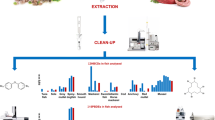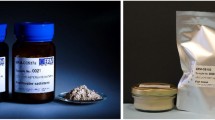Abstract
Background and aims
Hexabromocyclododecane (HBCD) is a brominated flame retardant used mainly in polystyrene foam as well as in textile applications. In recent years, measures were taken to reduce HBCD emissions during its production and use. To evaluate the efficacy of these measures, a monitoring project was initiated with fish as bioaccumulation indicators.
Methods
Since 2007 bream was sampled annually at several European freshwater sites applying standardized methods. Muscle samples were analyzed by a validated liquid chromatography–tandem mass spectrometry (LC-MS/MS) method which allows the quantification of α-, β-, and γ-diastereomers of HBCD.
Discussion
In most samples, α-HBCD was predominant. The lowest HBCD levels (11 μg/kg lipid weight (lw), sum of three HBCD diastereomers) were detected in bream sampled in 2009 from Lake Belau which is situated in a rural area of Northern Germany. During the 4-year study period, statistical significant decreases of HBCD concentrations were detected in bream from the rivers Rhone (France; −85%, level 2010, 205 μg/kg lw) and Western Scheldt (the Netherlands; −60%, level 2010, 36 μg/kg lw). High HBCD concentrations (9,480–14,500 μg/kg lw) without a clear time trend were observed in bream from the river Tees (UK). These high levels are in line with published data for fish from contaminated regions.
Conclusions
Overall, the results indicate that environmental burdens of HBCD are decreasing at those locations where point sources and more diffuse emissions are expected.


Similar content being viewed by others
References
Bignert A (2007) PIA statistical application developed for use by the Arctic Monitoring and Assessment Programme (Trend Analysis Package). http://www.amap.no/documents/index.cfm?dirsub=/PIA%20Trend%20Analysis%20Package. Accessed 08 August 2011
Boehmer W, Ruedel H, Wenzel A, Schroeter-Kermani C (2004) Retrospective monitoring of triclosan and methyl-triclosan in fish: results from the German environmental specimen bank. Organohalogen Comp 66:1489–1494. http://www.dioxin20xx.org/pdfs/2004/04-645.pdf. Accessed 08 August 2011
Bogdal C, Naef M, Schmid P, Kohler M, Zennegg M, Bernet D, Scheringer M, Hungerbühler K (2009) Unexplained gonad alterations in whitefish (Coregonus spp.) from Lake Thun, Switzerland: levels of persistent organic pollutants in different morphs. Chemosphere 74:434–440
Bromley PJ (2003) The use of market sampling to generate maturity ogives and to investigate growth, sexual dimorphism and reproductive strategy in central and south-western North Sea sole (Solea solea L.). ICES J Marine Sci 60:52–65. http://icesjms.oxfordjournals.org/cgi/reprint/60/1/52.pdf. Accessed 08 August 2011
Cheaib Z, Grandjean D, Kupper T, de Alencastro LF (2009) Brominated flame retardants in fish of Lake Geneva (Switzerland). Bull Environ Contam Toxicol 82:522–527
COT (2004) Committee on toxicity of chemicals in food consumer products and the environment: statement on brominated flame retardants in fish from the Skerne–Tees Rivers system. Corrected version April 2004. http://cot.food.gov.uk/pdfs/bfrstatement.pdf. Accessed 08 August 2011
Covaci A, Gerecke AC, Law RJ, Voorspoels S, Kohler M, Heeb NV, Leslie H, Allchin CR, de Boer J (2006) Hexabromocyclododecanes (HBCDs) in the environment and humans: a review. Environ Sci Technol 40:3679–3688
EBFRIP (2010) European brominated flame retardant industry panel. The voluntary emissions control action programme—measurable achievements. Annual Progress Report 2009. Brussels, Belgium. http://www.vecap.info/uploads/VECAP_report_22%2001.pdf. Accessed 08 August 2011
ECHA (2008) Data on manufacture, import, export, uses and releases of HBCDD as well as information on potential alternatives to its use. European Chemicals Agency, Helsinki, Finland, 108 pp. http://echa.europa.eu/doc/consultations/recommendations/tech_reports/tech_rep_hbcdd.pdf. Accessed 08 August 2011
Eljarrat E, de la Cal A, Raldua D, Duran C, Barcelo D (2004) Occurrence and bioavailability of polybrominated diphenyl ethers and hexabromocyclododecane in sediment and fish from the Cinca River, a tributary of the Ebro River (Spain). Environ Sci Technol 38:2603–2608
Esslinger S, Becker R, Jung C, Schröter-Kermani C, Bremser W, Nehls I (2011) Temporal trend (1988–2008) of hexabromocyclododecane enantiomers in herring gull eggs from the German coastal region. Chemosphere 83:161–167
European Commission (2000) SANCO/3029/99 rev.4 (11/07/2000): Residues: guidance for generating and reporting methods of analysis in support of pre-registration data requirements for Annex II (part A, Section 4) and Annex III (part A, Section 5) of Directive 91/414. Directorate General Health and Consumer Protection, Brussels. http://ec.europa.eu/food/plant/protection/evaluation/guidance/wrkdoc12_en.pdf. Accessed 08 August 2011
European Commission (2004) SANCO/825/00 rev. 7 (17/03/2004): Guidance document on residue analytical methods. Directorate General Health and Consumer Protection, Brussels. http://ec.europa.eu/food/plant/protection/resources/guide_doc_825-00_rev7_en.pdf. Accessed 08 August 2011
European Commission (2008) Risk assessment hexabromocyclododecane, CAS-No. 25637-99-4, EINECS No. 247-148-4. Final Report. May 2008, 507 pp. http://esis.jrc.ec.europa.eu/doc/existing-chemicals/risk_assessment/REPORT/hbcddreport044.pdf. Accessed 08 August 2011
Gerecke AC, Kohler M, Zennegg M, Schmid P, Heeb NV (2003) Detection of α-isomer dominated HBCD (hexabromocyclododecane) in Swiss fish at levels comparable to PBDEs (polybrominated diphenyl ethers). Organohalogen Compd 61:155–158. http://www.dioxin20xx.org/pdfs/2003/03-177.pdf. Accessed 08 August 2011
Hajslová J, Pulkrabová J, Poustka J, Cajka T, Randák T (2007) Brominated flame retardants and related chlorinated persistent organic pollutants in fish from river Elbe and its main tributary Vltava. Chemosphere 69:1195–1203
Harrad S, Abdallah MA, Rose NL, Turner SD, Davidson TA (2009) Current-use brominated flame retardants in water, sediment, and fish from English lakes. Environ Sci Technol 43:9077–9083
Heeb NV, Schweizer WB, Kohler M, Gerecke AC (2005) Structure elucidation of hexabromocyclododecanes—a class of compounds with a complex stereochemistry. Chemosphere 61:65–73
Hrádková P, Pulkrabová J, Kalachová K, Hloušková V, Tomaniová M, Poustka J, Hajšlová J (2011) Occurrence of halogenated contaminants in fish from selected river localities and ponds in the Czech Republic. Arch Environ Contam Toxicol. doi:10.1007/s00244-011-9681-z
ISO/IEC 17025 (2005) General requirements for the competence of testing and calibration laboratories. International Organization for Standardization, Geneva, Switzerland
Janák K, Covaci A, Voorspoels S, Becher G (2005) Hexabromocyclododecane in marine species from the Western Scheldt estuary: diastereoisomer- and enantiomer-specific accumulation. Environ Sci Technol 39:1987–1994
Klein R (1993) The animal specimens of terrestrial and limnetic ecosystems in the environmental specimen banking programme of Germany. Sci Total Environ 139–140:203–212
Klein R, Bartel M, Paulus M, Quack M, Tarricone K, Teubner D, Wagner G (2010a) Umweltprobenbank des Bundes: guideline for sampling and sample treatment—bream (Abramis brama). Biogeography, Trier University, Trier, Germany, Version V 2.0.1. http://www.umweltprobenbank.de/upb_static/fck/download/SOP_Bream.pdf. Accessed 08 August 2011
Klein R, Bartel M, Paulus M, Quack M, Tarricone K, Teubner D, Wagner G (2010b) Umweltprobenbank des Bundes: guideline for sampling and sample treatment—eelpout (Zoarces viviparus). Biogeography, Trier University, Trier, Germany. Version V 2.0.1. http://www.umweltprobenbank.de/upb_static/fck/download/SOP_Eelpout.pdf. Accessed 08 August 2011
Law RJ, Bersuder P, Allchin CR, Barry J (2006) Levels of the flame retardants hexabromocyclododecane and tetrabromobisphenol A in the blubber of harbour porpoises (Phocoena phocoena) stranded or bycaught in the U.K, with evidence for an increase in HBCD concentrations in recent years. Environ Sci Technol 40:2177–2183
Law RJ, Bersuder P, Barry J, Wilford BH, Allchin CR, Jepson PD (2008a) A significant downturn in levels of hexabromocyclododecane in the blubber of harbor porpoises (Phocoena phocoena) stranded or bycaught in the UK: an update to 2006. Environ Sci Technol 42:9104–9109
Law RJ, Herzke D, Harrad S, Morris S, Bersuder P, Allchin CR (2008b) Levels and trends of HBCD and BDEs in the European and Asian environments, with some information for other BFRs. Chemosphere 73:223–241
Li ZH, Zlabek V, Turek J, Velisek J, Pulkrabova J, Kolarova J, Sudova E, Berankova P, Hradkova P, Hajslova J, Randak T (2011) Evaluating environmental impact of STPs situated on streams in the Czech Republic: an integrated approach to biomonitoring the aquatic environment. Water Res 45:1403–1413
Nicholson MD, Fryer R, Larsen JR (1998) Temporal trend monitoring: robust method for analysing contaminant trend monitoring data. Techniques in Marine Environmental Sciences, No. 20. ICES, Copenhagen
Paulus M, Klein R, Wagner G, Müller P (1996) Biomonitoring and environmental specimen banking. Environ Sci Pollut Res 3:169–177
Pulkrabová J, Hajslová J, Poustka J, Kazda R (2007) Fish as biomonitor of polybrominated diphenyl ethers (PBDEs) and hexabromocyclododecane (HBCD) in aquatic environment: pollution of Elbe River-basin. Environ Health Perspect 115(suppl 1):28–34
Roosens L, Dirtu AC, Goemans G, Belpaire C, Gheorghe A, Neels H, Blust R, Covaci A (2008) Brominated flame retardants and polychlorinated biphenyls in fish from the river Scheldt, Belgium. Environ Int 34:976–983
Rüdel H, Böhmer W, Schröter-Kermani C (2006) Retrospective monitoring of synthetic musk compounds in aquatic biota from German rivers and coastal areas. J Environ Monit 8:812–823
Rüdel H, Uhlig S, Weingärtner M (2008) Umweltprobenbank des Bundes: guidelines for sampling and sample processing: pulverisation and homogenisation of environmental samples by cryomilling. Fraunhofer IME, Schmallenberg, Germany. Version V 2.0.0. http://www.umweltprobenbank.de/upb_static/fck/download/IME_SOP_preparation_Dez2008_V200.pdf. Accessed 08 August 2011
Salmi T, Määttä A, Anttila P, Ruoho-Airola T, Amnell T (2002) Detecting trends of annual values of atmospheric pollutants by the Mann-Kendall test and Sen’s slope estimates—the EXCEL template application MAKESENS. Report code FMI-AQ-31. Finnish Meteorological Institute, Helsinki, Finland
Smedes F (1999) Determination of total lipid using non-chlorinated solvents. Analyst 124:1711–1718
Stiehl T, Körner A, Ricking M, Sawal G, Warmbrunn-Suckrow E, Lepom P (2008) PBDE and HBCD levels in surface sediments from German rivers. Organohalogen Compd. 70:1590–1593. http://www.dioxin20xx.org/pdfs/2008/08-718.pdf. Accessed 08 August 2011
Umweltbundesamt (1996) Umweltprobenbank des Bundes—Verfahrensrichtlinien, Umweltbundesamt (ed.). Erich Schmidt Verlag, Berlin
Umweltbundesamt (2008) German environmental specimen bank—concept. Umweltbundesamt, Berlin, Germany. http://www.umweltprobenbank.de/upb_static/fck/download/concept_oct_2008_en.pdf. Accessed 08 August 2011
UNEP (2004) Guidance for a global monitoring programme for persistent organic pollutants, 1st edn, June 2004. Prepared by UNEP Chemicals, Geneva, Switzerland. http://www.chem.unep.ch/gmn/guidancegpm.pdf. Accessed 08 August 2011
UNEP (2010) Risk profile: hexabromocyclododecane. Stockholm Convention on Persistent Organic Pollutants. Document UNEP/POPS/POPRC.6/10. Review Committee, 11–15 October 2010. http://chm.pops.int/Convention/POPsReviewCommittee/POPRCMeetings/POPRC6/POPRC6Documents/tabid/783/language/en-US/Default.aspx. Accessed 08 August 2011
Van der Oost R, Beyer J, Vermeulen NPE (2003) Fish bioaccumulation and biomarkers in environmental risk assessment: a review. Environ Toxicol Pharmacol 13:57–149
Veith GD, Defoe DL, Bergstedt BV (1979) Measuring and estimating the bioconcentration factor of chemicals in fish. J Fish Res Board Can 36:1040–1048
Wenzel A, Böhmer W, Müller J, Rüdel H, Schröter-Kermani C (2004) Retrospective monitoring of alkylphenols and alkylphenol monoethoxylates in aquatic biota from 1985 to 2001: results from the German Environmental Specimen Bank. Environ Sci Technol 38:1654–1661
Acknowledgments
The authors thank the European Flame Retardant Association (EFRA), the PlasticsEurope Association, and the European Extruded Polystyrene Insulation Boards Association (EXIBA) for the long-term funding of the project “Environmental Monitoring of HBCD.” The contributions of Walter Böhmer, Dr. Annette Fliedner, Diana Homrighausen, Jens Nowak, Sonja Uhlig, and Martin Weingärtner (Fraunhofer IME Schmallenberg), and Martina Bartel-Steinbach, Lena Wilms, and Christian Ehrmantraut (University of Trier) to the project are gratefully acknowledged.
Author information
Authors and Affiliations
Corresponding author
Additional information
Responsible editor: Ake Bergman
This paper is a contribution to the series: “Chemical and Biological Environmental Monitoring (CBEM)” of the German Working Group on Environmental Monitoring (Editors H. Rüdel, Schmallenberg; W. Schröder, Vechta; K. T. von der Trenck, Karlsruhe; G. A. Wiesmüller, Cologne).
Electronic supplementary material
Below is the link to the electronic supplementary material.
ESM 1
(DOC 424 kb)
Rights and permissions
About this article
Cite this article
Rüdel, H., Müller, J., Quack, M. et al. Monitoring of hexabromocyclododecane diastereomers in fish from European freshwaters and estuaries. Environ Sci Pollut Res 19, 772–783 (2012). https://doi.org/10.1007/s11356-011-0604-3
Received:
Accepted:
Published:
Issue Date:
DOI: https://doi.org/10.1007/s11356-011-0604-3




